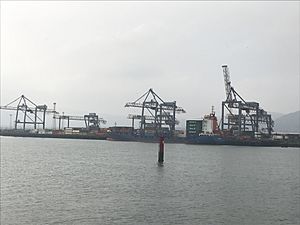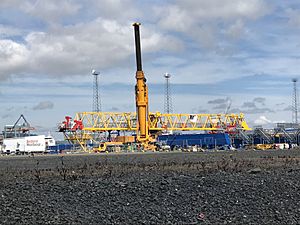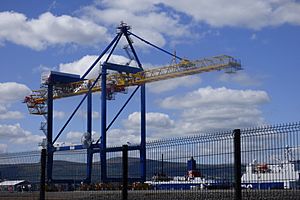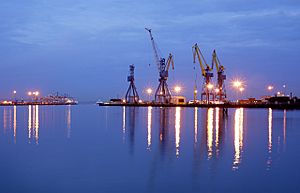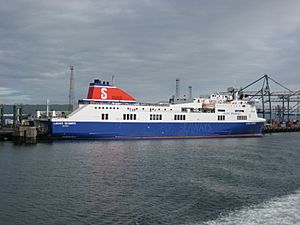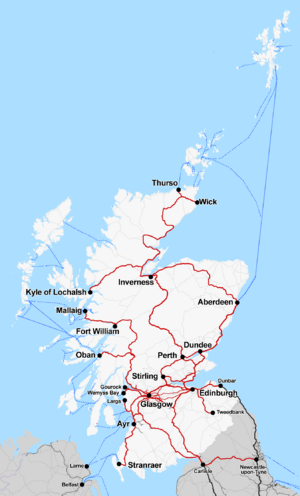Belfast Harbour facts for kids
Belfast Harbour is a really important port in Belfast, Northern Ireland. It handles a huge amount of Northern Ireland's trade by sea, about 67% of it! It also deals with about a quarter of all sea trade for the entire island of Ireland. This port is super important for bringing in raw materials, sending out goods, and getting consumer products to people. It's also a main place for storing and moving goods around Northern Ireland.
The land around Belfast Harbour is home to many famous Northern Ireland businesses. These include George Best Belfast City Airport, Harland and Wolff (where the Titanic was built!), Bombardier Aerospace, Odyssey, Catalyst Inc, Titanic Quarter, and Titanic Belfast. More than 700 companies, employing 23,000 people, are located here.
Belfast is one of only two ports in Ireland that can handle all kinds of cargo. This includes big freight vehicles, containers, dry goods, loose bulk items, liquids, and even passenger ferries and cruise ships. In 2015, Belfast Harbour handled 23 million tonnes of cargo.
BBC One Northern Ireland made a documentary series called Belfast Harbour: Cruises, Cranes and Cargo. It showed how important the Port of Belfast is to Northern Ireland's economy.
Contents
Port History: How Belfast Harbour Grew
Belfast Harbour started a very long time ago, back in 1613. A special document called a Royal Charter said that a wharf (a kind of dock) was needed where the Lagan and Farset rivers met. This area is now Belfast's High Street.
At first, the harbour was quite small and simple. George Benn, who wrote a history of Belfast in 1877, called it a "poor little harbour." But even then, it was the start of the huge docks and harbour we see today.
By 1663, records show that 29 ships were owned in Belfast. Trade kept growing, so the original quay (a platform for loading ships) had to be made bigger.
In the early 1700s, Belfast became the most important port in Ulster, taking over from Carrickfergus. More docks were built on land that was reclaimed from the water. As trade continued to grow, the Irish Parliament passed a law in 1785 to help manage the busy port. This led to a new group being formed, called 'the Ballast Board'. They took over running the port.
Even though the port was growing, it had problems. The water was shallow, the river channel had bends, and the quays weren't big enough. Most ships had to unload some of their cargo further downstream before they could reach the docks. This cost extra money and time.
To fix these issues, a new law was passed in 1837 by the Westminster Parliament. This law gave the Ballast Board more power to improve the port. Work began in 1839 to straighten the river, creating what is now known as the Victoria Channel. This channel was finished in 1849. Later, the Clarendon Dock opened in 1851, and the Dufferin and Spencer Docks opened in 1897.
In 1847, the Belfast Harbour Commissioners were formed. This new group had even more power. They continued to develop the port, creating more land for new quays and adapting to new types of ships and ways of handling cargo.
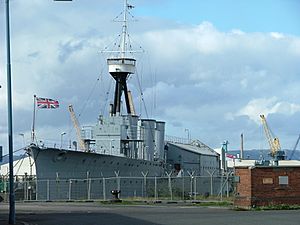
During World War II, the Port of Belfast was a key base for the Royal Navy. Many ships that protected convoys (groups of ships traveling together) across the Atlantic and to Russia used Belfast as their home. One famous ship, HMS Caroline, is a light cruiser from World War I. It was used as a training ship for naval reservists until 2011. After a lot of work to restore it, HMS Caroline opened to the public in June 2016 as a museum. You can visit it as part of the National Museum of the Royal Navy.
How Belfast Harbour is Managed
Belfast Harbour is a "Trust Port." This means it's not owned by the government. Instead, it's an independent body that has to run like a business. Its leaders, called the Belfast Harbour Commissioners, are chosen by Northern Ireland's Department for Regional Development.
There are currently fifteen Commissioners, led by a Chairman. They serve for three years. All of them, except the Chief Executive, are non-executive, meaning they don't handle the day-to-day running of the port.
Belfast Harbour Police
The port is patrolled by the Belfast Harbour Police. This police force is very old, going back over 160 years!
Today, the Harbour Police have new jobs because many parts of the port have been developed into new homes, shops, and public areas. So, besides helping traditional port users, they also provide policing services to people who live, work, and visit the Harbour Estate.
Port Operations: What Happens at the Harbour
Moving Goods: Freight
In 2019, a record number of freight vehicles, 542,000, used the port. These were on routes like Belfast-Loch Ryan, Belfast-Birkenhead, and Belfast-Heysham.
Also in 2019, the port handled 9.9 million tonnes of bulk cargo (like coal or grain) and over 130,000 shipping containers. These containers carried more than 2.1 million tonnes of goods. In total, the port handled over 24 million tonnes of trade in 2019!
In 1993, the container operations moved to Victoria Terminal 3 (VT3). This new terminal had special cranes to load and unload ships and stack containers. Over the years, different companies have operated this terminal.
In October 2019, Belfast Harbour announced a big £40 million project to upgrade VT3. This included getting eight new remote-controlled cranes and two new Liebherr ship-to-shore cranes. The first new Liebherr crane arrived in April 2020 and was put together in May 2020. It was then moved across the channel by a barge. The second new crane arrived in August 2020. These new cranes are replacing some of the older ones that have been there since 1993.
Taking People: Passenger Services
In 2014, 1.4 million passengers used the port's ferry services. Here are the main routes:
- Stena Line to Cairnryan: Stena moved its services from Stranraer to a new port at Cairnryan in 2011, using newer ferries.
- Stena Line to Birkenhead: Stena bought this route and renamed the ships. In early 2020, a new super ferry, the Stena Edda, started on this route. The terminal was upgraded to fit these bigger ships.
- Isle of Man Steam Packet Company to Douglas, Isle of Man
Ferry and Train Connections
You can connect from Belfast to Glasgow Central by taking a bus from Cairnryan to Stranraer, and then a train along the Glasgow South Western Line.
| Preceding station | Ferry | Following station | ||
|---|---|---|---|---|
| Stranraer Harbour (via bus link from Cairnryan) |
Stena Line Ferry |
Terminus (nearest stations Yorkgate, Lanyon Place & Belfast Great Victoria Street) |
||
| Liverpool | Stena Line Ferry |
Terminus (nearest stations Yorkgate, Lanyon Place & Belfast Great Victoria Street) |
||
| Holyhead | Stena Line Ferry |
Terminus (nearest stations Yorkgate, Lanyon Place & Belfast Great Victoria Street) |
||
| Douglas | Isle of Man Steam Packet Ferry (Seasonal) |
Terminus (nearest stations Yorkgate, Lanyon Place & Belfast Great Victoria Street) |
There's also a Metro bus Service 96 that connects to Yorkgate. From there, you can get on the Londonderry Line and other Belfast Suburban Rail trains.
Visiting Ships: Cruise Ships
Belfast Harbour is becoming very popular with cruise ships! In 2016, it was the busiest cruise season ever for the city, with over 145,000 passengers and crew visiting.
Cruise ships use two main berths (places to dock):
- The Pollock Dock, for smaller ships (457 meters long, 8.5 meters deep). It's named after a Northern Irish politician, Hugh MacDowell Pollock.
- The Stormont Wharf (a deep-water berth) for larger ships (177 meters long, 10.2 meters deep). The extended Stormont Wharf was opened in 2009 by the Grand Princess.
Harbour Property: Land and Buildings
Belfast Harbour owns a lot of land, about 1950 acres! About 855 acres are used for port activities. 90 acres are kept for nature, and the remaining 1,005 acres are rented out or being discussed for future use.
Titanic Quarter
One of Belfast Harbour's biggest projects is the Titanic Quarter. This area is developed with Titanic Quarter Limited.
Holywood Exchange
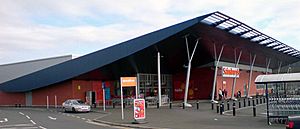
Belfast Harbour Commissioners started planning Holywood Exchange in 1995. After some challenges, construction began in December 2002. This development now includes a large retail park with 11 shops, a Sainsbury's supermarket and petrol station, and a B&Q store. A huge IKEA store also opened there in 2007.
City Quays
City Quays is a modern area with office buildings (City Quays 1 and City Quays 2). It also has shops, cafes, restaurants, and other services.
Other Places in the Harbour Estate
The Odyssey Complex is a big sports and entertainment center in the Belfast Harbour Estate. It includes the Odyssey Pavilion, the SSE Arena Belfast, and W5 (a science and discovery center). The land for the Odyssey arena and pavilion is owned by The Odyssey Trust, who lease it from Belfast Harbour Commissioners.
Images for kids
See also
 In Spanish: Puerto de Belfast para niños
In Spanish: Puerto de Belfast para niños


